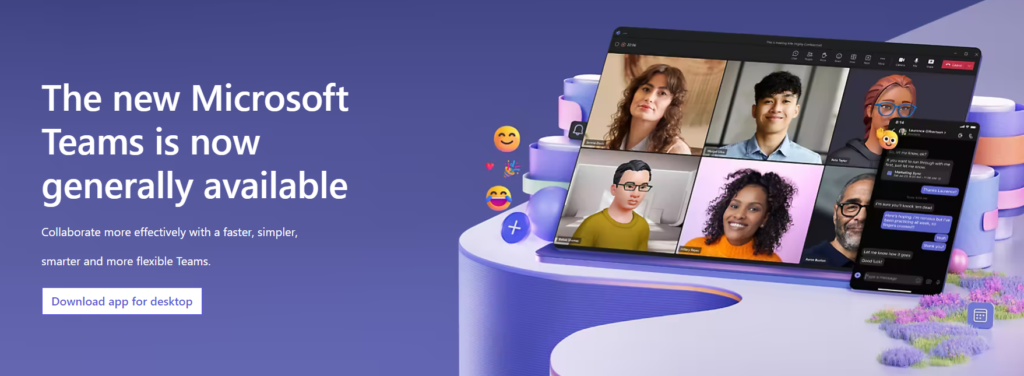Microsoft Teams is a powerful collaboration tool that forms part of the Microsoft 365 suite of services. Designed to enhance workplace communication, coordination, and efficiency, Teams provides a comprehensive platform where users can meet, chat, call, and collaborate all in one place. This application facilitates not only day-to-day communication but also detailed project management and long-term planning.
At its core, Microsoft Teams supports real-time messaging, video meetings, and file sharing, integrating smoothly with Microsoft Office products like Word, Excel, and PowerPoint. These integrations allow for seamless collaboration on documents without needing to switch between applications. Users can organize their discussions into channels and teams, making it easier to manage tasks and information flow based on projects or departments.
Security is a critical aspect of Microsoft Teams, ensuring that communications and collaborations are protected through end-to-end encryption and compliance with international security standards. This makes it an ideal choice for industries ranging from education to finance, where data sensitivity is paramount.
As remote work becomes more prevalent, Microsoft Teams stands out as an essential tool for businesses looking to maintain productivity and connectivity in a dispersed work environment, proving itself as much more than just a messaging app.
Overview of its significance in modern workplaces
Microsoft Teams has become a linchpin in modern workplaces, particularly as organizations navigate the complexities of remote and hybrid work models. Its comprehensive set of features supports not just communication, but also the intricate dynamics of collaboration and project management across various sectors. As workplaces evolve, the need for a unified platform that can manage multiple aspects of work efficiently has never been more critical.

Teams enables real-time communication through chats and video calls, reducing delays and enhancing the responsiveness of teams. This immediacy is crucial for fast-paced environments where quick decision-making can impact project outcomes significantly. Additionally, its deep integration with Microsoft 365 means that documents, spreadsheets, and presentations can be collaborated on in real time, ensuring that all team members are always on the same page.
Moreover, the platform’s scalability makes it suitable for both small teams and large enterprises, adapting as organizations grow. The ability to customize and extend its functionality through third-party apps and integrations further enhances its utility, making it a versatile tool in any business’s arsenal. In a world where flexibility and efficiency are paramount, Microsoft Teams stands out as a vital tool for maintaining continuity, driving productivity, and fostering a collaborative corporate culture.
Core Features of Microsoft Teams
- Communication tools: Chat, calls, meetings, and live events.
- Collaboration tools: File sharing, real-time document collaboration, and project channels.
- Integration capabilities: Office 365 integration and third-party app support.
Industry-Specific Applications
- Healthcare
- Coordinating patient care with secure communication channels.
- Compliance with health data protection standards.
- Education
- Virtual classrooms and distance learning facilitation.
- Assignment distribution and grading systems integration.
- Manufacturing
- Streamlining operations through team channels.
- Enhancing safety protocols with immediate communications.
- Retail
- Managing supply chains and inventory through integrated apps.
- Enhancing customer service with quick team coordination.
- Finance
- Secure document sharing and real-time financial collaboration.
- Compliance tools for regulatory requirements.
Improving Staff Efficacy with Microsoft Teams
- Real-time communication enhancing immediate problem-solving.
- Reduction in email clutter and streamlined communication.
- Faster decision-making with all information in one place.
Best Practices for Implementing Microsoft Teams
- How to effectively set up Teams for different industry needs.
- Training staff to maximize the use of all features.
- Ongoing support and learning resources for continual improvement.
Future of Workplace Collaboration
The future of workplace collaboration is poised to be driven by an increasing reliance on digital platforms that facilitate not just communication, but deep, meaningful integration between team members, regardless of their physical locations. As we look forward, the emphasis will shift more towards tools that can seamlessly combine real-time communication with robust project management features, adapting to the diverse needs of global teams.
Emerging technologies like artificial intelligence (AI) and machine learning (ML) are set to further revolutionize these collaborative tools, enhancing their ability to automate routine tasks and provide personalized recommendations. This could mean smarter scheduling, predictive assistance, and even automated content creation that streamlines workflows more efficiently than ever before.
Moreover, as the distinction between physical and virtual workspaces continues to blur, we’ll see a greater focus on creating seamless user experiences that can replicate in-person interactions as closely as possible. Virtual reality (VR) and augmented reality (AR) technologies could soon integrate into collaboration platforms, offering more immersive meeting experiences and enabling more engaging and productive remote work environments.
In conclusion, the future of workplace collaboration will focus on creating more intelligent, intuitive, and immersive tools that make remote work not just manageable but more advantageous, fostering a more dynamic, flexible, and inclusive global workforce.


1 thought on “Enhancing Industry Efficiency: How Microsoft Teams Boosts Staff Productivity Across Sectors”
Comments are closed.